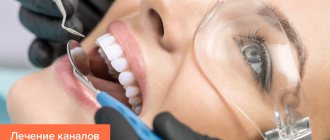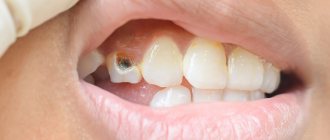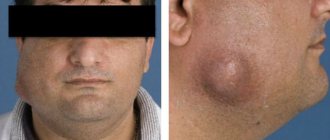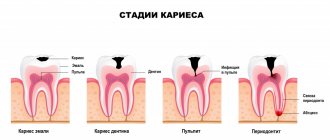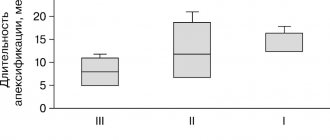Dermatovenerologist
Khasanova
Alina Rashidovna
9 years experience
Make an appointment
Redness of the skin in a certain area of the body, caused by the expansion of the vascular network and increased blood flow into these vessels, is called erythema. Unlike the manifestations of hemorrhage, when pressing on the affected area of the skin, the redness disappears. Skin reactions are caused by various factors - adverse external influences, inflammatory processes, pathological changes. Red spots appearing on the skin may have clear or blurred boundaries, accompanied by swelling, peeling, itching, etc.
Types of pathology
Erythema is classified according to the type of vessels affected:
- active - occurring with a sharp expansion of the lumen of arterial vessels, accompanied by an acute inflammatory process, with bright redness of the skin, increased temperature, swelling and soreness of the skin;
- passive - formed when blood stagnates in the venous vessels during their expansion, accompanied by the appearance of bluish-red or burgundy spots, mainly accompanying inflammation with a chronic course.
Each variety is caused by different causative factors and requires a separate therapeutic approach.
Based on etiology, the following types of erythema are distinguished:
- non-infectious - which are the physiological reaction of the body to external or internal irritants (solar ultraviolet radiation, critically high or low temperature, allergens, etc.);
- infectious - caused by the penetration of infection into the skin capillaries through the surface of the epidermis, from the systemic bloodstream or through the mucous membrane.
Non-infectious manifestations usually do not require special treatment, as they go away on their own after the action of the provoking factor ceases. Infectious reactions are expressed in an inflammatory process that occurs in an acute or chronic form and is accompanied by certain symptoms.
Erythema nodosum
Hepatitis
Arthritis
Colitis
Allergy
19494 08 February
IMPORTANT!
The information in this section cannot be used for self-diagnosis and self-treatment.
In case of pain or other exacerbation of the disease, diagnostic tests should be prescribed only by the attending physician. To make a diagnosis and properly prescribe treatment, you should contact your doctor. Erythema nodosum: causes, symptoms, diagnosis and treatment methods.
Definition
Human skin consists of epidermis and dermis. The epidermis serves to protect the underlying tissues from mechanical, chemical, thermal damage, as well as from the penetration of infectious agents. The dermis is a layer of skin that includes a network of blood vessels, subcutaneous fatty tissue (SAT), connective tissue fibers, hair follicles, sweat and sebaceous glands.
Erythema nodosum is an inflammatory lesion of small vessels of the skin and subcutaneous fatty tissue, which is a type of panniculitis (inflammation of fatty tissue that develops against the background of other diseases or is idiopathic in nature).
Causes of erythema nodosum
Unfortunately, it is not always possible to establish for certain what led to the appearance of erythema nodosum. This poses difficulties in determining treatment tactics for such a condition. Most often, erythema nodosum is found in adults of reproductive age. In children and adolescents, it can develop against the background of a previous streptococcal infection.
The cause of the inflammatory process, which results in erythema nodosum, can be infectious agents, autoimmune diseases, allergic reactions, taking medications (sulfonamides, penicillin antibiotics, oral contraceptives, bromides, etc.). Pregnancy can also provoke the appearance of erythema nodosum.
Under the influence of these factors, lymphocytes are activated, the immune system begins to produce specific antibodies and inflammation develops. However, such a response of the body is not detected in every person, which suggests a special predisposition to such an immune response, and the predisposition can be either hereditary or acquired.
Erythema nodosum usually develops in the presence of two conditions: specific abnormal activity of the immune system and a provoking factor (trigger).
Among infectious diseases, such triggers are often streptococcal infection, tuberculosis, chlamydia, hepatitis B and C, etc.
The incidence of erythema nodosum in autoimmune diseases is high. This is a group of diseases that are based on a violation of the immune system’s recognition of “self” and “foreign” cells. As a result, immune cells begin to show aggression against cells of their own body, just as they would be activated when meeting infectious agents or cancer cells.
Erythema nodosum is common in sarcoidosis. One form of sarcoidosis (Löfgren's syndrome) is a combination of bilateral damage to the lymph nodes located in the roots of the lungs, joints, fever and erythema nodosum.
Other autoimmune diseases associated with the development of erythema nodosum include:
- systemic lupus erythematosus;
- rheumatoid arthritis;
- Behçet's disease (a disease based on vascular inflammation);
- Sjögren's disease (a disease that primarily affects the salivary and lacrimal glands);
- nonspecific ulcerative colitis (severe inflammatory damage to the colon), etc.
Sometimes erythema nodosum develops against the background of various malignant neoplasms, which include leukemia, lymphoma, pancreatic cancer, etc.
Classification of erythema nodosum
Erythema nodosum can be either an independent disease of unknown etiology (
primary or idiopathic erythema nodosum
) or develop as part of other diseases (
secondary erythema nodosum
). This classification is extremely important for determining the patient’s treatment tactics, because the treatment of secondary erythema nodosum is based on the effect on the underlying disease.
Erythema nodosum may have an acute
,
migratory
or
chronic course
.
Symptoms of erythema nodosum
The clinical features of erythema nodosum depend on the etiological factors and the nature of the process.
Primary (idiopathic) erythema nodosum manifests itself acutely - bright red painful confluent nodes form on the legs against the background of swelling of the legs and feet.
In acute cases, the nodes develop rapidly. Characterized by a concomitant increase in temperature to 38-39°C, weakness, headache, arthralgia. The disease is preceded by viral infections or tonsillitis. The nodes usually disappear without a trace after 3-4 weeks without ulceration, relapses are rare.
Migratory erythema nodosum is characterized by an acute course with an asymmetric inflammatory component. The main node is dense, bluish-red in color, delimited from the surrounding tissues. As a result of peripheral growth due to the migration of the inflammatory infiltrate, a ring-shaped plaque is formed with a sunken pale center and a wide, more saturated peripheral zone. Single small nodules may appear, including on the opposite shin. The duration of the disease is up to several months. During the formation of nodes, concomitant general disorders in the form of chills, weakness, arthralgia, and low-grade fever may be observed.
Chronic erythema nodosum usually occurs in middle-aged and elderly women, often against the background of vascular, allergic, inflammatory, infectious or tumor diseases. Exacerbation occurs more often in spring and autumn. Nodes with moderate pain and the size of a walnut are localized on the legs (on the anterolateral surface), swelling of the legs and feet is observed. Relapses can last for months.
Diagnosis of erythema nodosum
The diagnosis of erythema nodosum is made based on the clinical picture. This suggests that the data obtained during the conversation with the patient and examination is sufficient. However, to select treatment, it is necessary to establish causative and concomitant diseases. For this purpose, the patient may be prescribed the following studies:
- A clinical blood test with a leukocyte count, which will allow you to assess the intensity of inflammatory processes in the body, suspect the cause, and identify changes characteristic of leukemia and lymphoma.
Non-infectious manifestations
In accordance with the causes that caused them, erythema of non-infectious etiology is divided into:
- infrared - provoked by infrared radiation, the power of which was not enough for a full burn, and manifested in the form of a reddish vascular network;
- X-ray – caused by exposure to X-rays or high-frequency electromagnetic waves;
- symptomatic - appearing after contact with an allergenic agent in the form of hyperemic convex spots of irregular shape;
- idiopathic - formed under the influence of heredity as an increase in the diameter of capillaries at the junction with the vascular network, with redness of the palmar surfaces;
- cold - formed when the skin is exposed to low temperatures, manifesting itself in the form of a bluish-reddish rash with local swelling and itching;
- ultraviolet - appearing as a result of exposure to ultraviolet radiation on the skin.
In most cases, when the action of the provoking factor ceases, the redness disappears after some time. In some cases, symptomatic help is required.
Causes of erythema multiforme exudative
Modern dermatology is not ready to clearly identify the objective causes and mechanisms of development of exudative erythema multiforme. It is known that approximately 70 percent of people have a certain focus of chronic infection: sinusitis, otitis, chronic tonsillitis, pulpitis, pyelonephritis, periodontal disease and many other diseases, as well as increased sensitivity to antigens. In these patients, during an exacerbation of exudative erythema multiforme, a decrease in immunity is recorded. As a result, there was an assumption that the onset and exacerbation of the disease are caused by immunodeficiency, which develops rapidly against the background of focal infections in interaction with some complicating and provoking factors, namely:
- hypothermia;
- sore throat;
- ARVI.
Erythema multiforme is often associated with herpetic infections.
The main and most common cause of the toxic-allergic form of the disease is intolerance to certain medications:
- sulfonamides;
- barbiturates;
- tetracycline;
- amidopyrine and others.
In addition, the disease may appear after administration of serum or vaccine. From the point of view of allergology, exudative erythema multiforme is a mixed type hyperreaction, combining signs of immediate and delayed hypersensitivity.
Infectious pathologies
Various pathogens can provoke the development of infectious inflammation of the skin - bacteria, fungi, viruses or parasites. This form is characterized by an acute course, which can turn into a chronic form. The patient needs immediate medical attention.
In its acute form, the most common erythema infectiosum in children is caused by parvovirus B19. It is characterized by the sudden onset of the disease, the characteristic signs of which are:
- rapidly rising body temperature;
- muscle pain, headache;
- the appearance of a red rash covering the face and body on the third or fourth day after the onset of the disease;
- gradual increase and closure of spots.
After some time, clinical manifestations gradually fade away until they disappear completely. If left untreated, the process can become chronic. The patient remains able to transmit the infection to healthy people for several days after recovery.
Nodular pathologists
The causative agent of erythema nodosum is usually streptococcus, and less often - some other infections. It often occurs against the background of tonsillitis, scarlet fever, and tuberculosis. You can recognize it by the following signs:
- rashes of bright red color, with bulges forming in the subcutaneous layer;
- asymmetrically located spots;
- gradual bluing of the spots, then yellowing, similar to the resorption of bruises;
- presence of fever;
- painful sensations and itching in the affected areas of the skin;
- the presence of multiple seals on the legs.
The patient is prescribed a course of antibiotics, antihistamines, as well as external treatment with antiseptics.
Multiform exudative pathologies
The etiology is still not fully understood. The cause is believed to be an infection present in the body. The disease is usually chronic, with constant relapses. Symptoms of erythema multiforme exudative type are:
- slight increase in temperature;
- pain in muscles and joints;
- rashes with a central papule and clear boundaries of spots, located mainly on the bends of the limbs;
- uneven color of spots;
- symmetrical location of rashes on the body;
- tendency to grow with the formation of “garlands”;
- slight deterioration in general health.
The main difficulty is diagnosis, since the signs partially correspond to a number of other diseases. Before prescribing a course of therapy, differential diagnosis is carried out. Medicines are selected taking into account the age characteristics of the patient.
The clinical picture is characterized by an acute onset. The disease often begins with prodromal phenomena (fever, malaise, pain in muscles and joints, sore throat).
After the prodromal period, polymorphic rashes on the skin appear in spurts (over 10-15 days or more) - erythema, papules, blisters. Depending on the severity of clinical manifestations, the following forms of the disease are distinguished:
Mild simple (papular) form
The primary morphological elements are hyperemic spots (erythema), papules and vesicles. Papules are round in shape with clear boundaries, ranging in size from 0.3 to 1.5 cm, red-bluish in color, flat, dense on palpation, prone to centrifugal growth with retraction of the central part.
An edematous ridge forms along the periphery of the papules, and the center of the element, gradually sinking, acquires a cyanotic tint (symptom of “target”, or “iris”, or “bull’s eye”. Characteristic are target-shaped lesions less than 3 cm in diameter with clearly defined edges, in structure which are divided into three different zones:
- central disk of dark erythema or purpura that may become necrotic or transform into a dense vesicle
- ring of palpable, pale, swollen area
- outer ring of erythema.
Subjectively, the rash is accompanied by itching. Pathological elements tend to merge to form garlands and arcs. The bubbles are round in shape, small, flat, have a thick covering, are filled with opalescent liquid, and are usually located in the center of the papules.
Secondary morphological elements are erosions, crusts, scales, hyperpigmented spots that do not have clinical features.
The rashes usually appear suddenly, are often located along the periphery, symmetrically on the skin of the dorsum of the feet and hands, palms, extensor surfaces of the forearms and legs, the red border of the lips with the formation of crusts, the mucous membrane of the oral cavity, less often on the neck and torso. Often, only the hands are selectively affected. Damage to the eyes and genitals is observed less frequently. Blisters may form on the mucous membranes, which open to form painful erosions. Resolution of the rash continues within 2-3 weeks, without leaving scars. Pigment spots that appear in place of former papules are yellowish-brown in color.
Vesiculobullous form
The vesiculobullous form occupies an intermediate position between the papular and severe bullous forms. The lesions are represented by erythematous plaques with a bubble in the center and a ring of bubbles along the periphery. Often the mucous membranes are involved in the process.
Severe bullous form
In the severe bullous form (Stevens-Johnson syndrome), the onset is acute, sometimes with prodromal phenomena. Skin, eyes, mucous membranes of the oral cavity, genitals, and perianal area are affected; bronchitis and pneumonia develop. Extensive blisters appear on the oral mucosa with the formation of erosions, which are covered with massive hemorrhagic crusts. The development of catarrhal or purulent conjunctivitis is characteristic, against which blisters may sometimes appear.
Corneal ulceration, uveitis and panophthalmitis with loss of vision often develop. Damage to the mucous membranes of the genitals in men leads to impaired urination with possible involvement of the bladder in the process. Maculopapular rashes or blisters on the skin are noted, less often - pustules, significant in size and number. The period of rash is 2–4 weeks. Skin syndrome is accompanied by fever, pneumonia, nephritis, diarrhea, polyarthritis, etc. Paronychia and otitis media are sometimes associated. Without treatment, the mortality rate for Stevens-Johnson syndrome reaches 5–15%. With all variants of exudative erythema multiforme, there is a tendency to relapse
Migratory type pathology
Infectious dermatosis in the form of migratory erythema after a tick bite initially looks like a slight redness, which quickly increases in size and becomes ring-shaped with a clear hyperpigmented border. Unpleasant sensations, itching or burning may occur in the affected area. The stain persists for several days, in some patients up to a month. If left untreated, the disease becomes chronic, which is difficult to treat.
The disease is caused by the bacterium Borrelia, which is carried by ticks. The pathogen spreads in the body through the lymphatic and circulatory systems, penetrates various organs and other areas of the skin. The joints, muscles, and nerve tissues are most often affected, and less commonly, the tissues of the heart muscle and the lining of the brain.
Are you experiencing symptoms of erythema?
Only a doctor can accurately diagnose the disease. Don't delay your consultation - call


